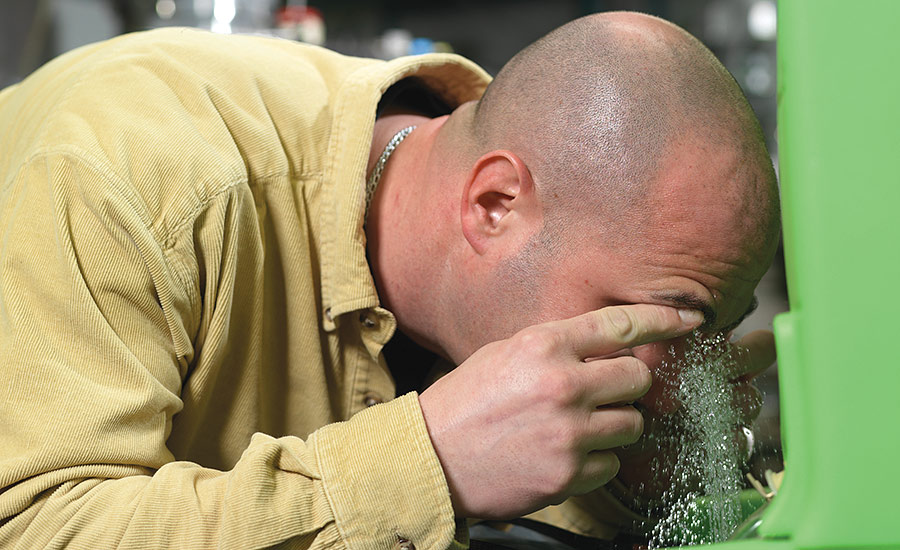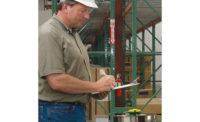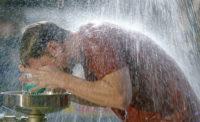Emergency eyewash equipment is required anywhere concentrated corrosives (acids or bases), cleaners, disinfectants or other chemicals or substances that could injure the eyes are present. Every building containing custodial closets, laboratories, pesticide mixing stations, chemical mixing or transport areas, darkrooms, warehouses, hair salons, battery charging stations and more requires such a station.
The best time to consider emergency eyewash options is at the outset of planning a new building. Factors such as location, portability, reliability, maintenance, cost and efficacy all play a role in determining the type of station that will meet the needs of employers and workers alike.
Make eyewash accessible
When an occupational eye injury occurs, proper and immediate treatment is the best strategy for a positive outcome. If treatment is delayed — even for a few seconds — serious injury can result, leading to significant direct and indirect costs to employers as well as expense and diminished quality of life for the affected individual. To protect workers and employers from the effects of an eye injury, OSHA requires employers to provide suitable eye and face protection “whenever necessary to protect against chemical, environmental, radiological or mechanical irritants and hazards.”
Plus, OSHA references the American National Standards Institute (ANSI) Z358.1-2014 standard for specific details on establishing and maintaining proper work practices relating to eye safety.
In the event that a harmful chemical makes contact with a worker’s eye, ANSI calls for the immediate flushing of both eyes with potable water for a full 15 minutes. Because the first 10 to 15 seconds following exposure are critical, eyewash is to be located within a 10-second walk from hazards — and immediately adjacent to strong caustics and strong acids. To ensure rapid access, ANSI calls for the station to be located on the same level as the hazard with no steps, stairs or other obstructions along the path.
The surrounding area should be well lit and marked with a sign that is highly visible. Remember, an injured worker may have limited or no vision while en route to the station. For this reason, eyewash should never be placed where an injured person could have difficulty reaching or operating the station. When planning a new space, determine where harmful chemicals will pose safety risks, then determine where emergency eyewash stations should be located to meet national, local and employer-based safety requirements.
Ensure safe and easy treatment
Once eyewash locations have been planned, there are two types of eyewash stations to consider. Plumbed eyewash stations have been a long-standing solution. They deliver tap water in plentiful amounts. But tap water can be detrimental to treat injured eyes:
? Because a compromised eye has less resistance to infection than the bloodstream, harmful microorganisms and other contaminants commonly found in tap water can cause serious long-term effects;
? Since it does not match the eye’s natural pH, flushing with tap water can cause further irritation; and
? The temperature of plumbed water is not easily regulated, and is often too hot or too cold to carry out ANSI’s required 15-minute flush.
Portable eyewash stations are available various sizes and styles. Easy to install, portable stations can be moved within close proximity of practically any hazard. Because they are self-contained, portable stations store and deliver preserved and/or pH-balanced water or saline solution at room temperature for safe and comfortable flushing. For further ease of use, look for portable stations that feature ergonomic design, alarm systems that encourage the ANSI-required 15-minute flush, and self-contained reservoirs that capture waste water.
Design with cost savings in mind
Another important consideration in designing a safe workplace is cost. Portable units cost a few hundred dollars per station; are easy to install, move or replace; and require minimal maintenance. Self-contained tank style portable devices may require cleaning, disinfecting and changing the flushing fluid as infrequently as every three to six months, as directed by the manufacturer. Sealed cartridge devices containing sterile or purified, buffered saline solution require the least maintenance, remaining free of bacteria and contamination for up to 24 months.
Look for portable stations equipped with RFID technology that provides instant insight into maintenance schedules, helps manage inventory, tracks expiration dates and more using a handheld computer.
By understanding eyewash standards and the many factors involved in selecting effective eyewash delivery options, employers can build best-in-class safety mechanisms into new construction from the ground up. Such informed decisions can result in significant cost savings for employers and the healthiest outcomes for workers, and that’s a foundation worth building.






